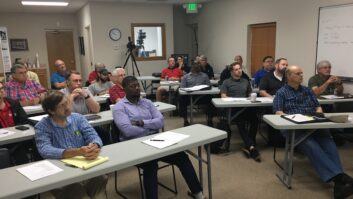Lest you think copper theft is the worst that could happen to a broadcast engineer, Cumulus Engineer Robert Combs said someone decided recently to use the WJAD(FM) transmitter building in Albany, Ga., for target practice.

Fig. 1: Bullets penetrated this transmitter building.
Judging from the bullet holes, seen in Fig. 1, a smaller-caliber hunting rifle was used.
Contact law enforcement if you experience station vandalism of any kind. Robert got in touch with the Lee County Sheriff Office, which took a report. They turned the case over to detectives but at last word there was no movement in the case.
From the angle of the bullet holes, the shots came from the property gate or the house next to the gate. As you can see, bullets penetrated the building wall. Fortunately, nothing inside was damaged and no one was hurt, though the transmitter side was dented.
Do engineers now need to worry about wearing bullet-proof vests when visiting transmitter sites?
You may recall me telling you several years ago about two separate incidents of site vandalism. Both engineers reported the vandalism not only to local law enforcement officials but also to the FBI, since radio stations are federally-licensed facilities and this was not long after 9/11.
In one instance, the field agent made a thorough effort to identify the perpetrators, who ultimately were arrested. In the other, though, the agent’s attitude essentially was, “You’ve got to be kidding. I don’t have the time for that.”

Fig. 2: Fortunately, the only dents were to the exterior of the transmitter, not to humans.
Such situations should raise the ire of readers. Your thoughts and comments will be appreciated. My e-mail is at the end of the column.
* * *
Pete Baisner read about the broken neutral in the Jan. 12 Workbench. This reminded him of a situation he encountered some years ago.
A boy’s camp in sunny California was having trouble with its local generator not keeping a constant voltage with load cycling. The camp kept losing its microwave ovens on a regular basis. A simple modification to a GFCI solved their problem and the fix is working to this day.
The modification involved a SIDAC or silicon diode for alternating current, a member of the thyristor family available from Digi-Key or Mouser for less than a dollar, and a 2 watt resistor from 10k to 20k or so. The SIDAC and resistor are wired in series from the ground fault circuit interrupter AC input brass terminal (black wire, hot leg) to the GFCI output side (load side) to the silver terminal (neutral leg).
In case of an overvoltage situation, the SIDAC turns on and a few milliamps of current upsets the GFCI and it shuts off, thus protecting the equipment connected to the load side of the GFCI.
To get really fancy, one could even put an LED and a diode in series with the resistor/SIDAC combo and get a visual indication of overvoltage problems.
The SIDACS come in all kinds of voltage breakdowns. Teccor/Littelfuse part #K1300G is rated 120–138 volts, and part #K1200E70 is rated from 110–125 volts. You could also add a second resistor to the incoming AC side, forming a voltage divider, and choose the exact cutoff voltage.
At this point it might be a good idea to ascertain that the AC loads are well balanced and that there is not a lot of current in the AC neutral. It’s also a good time to make sure there is no current in the EGC or equipment grounding conductor, also known as the GREEN wire.
A clamp-on ammeter is a most useful tool for this job.
A Cen-Tech Model 96308 available from Harbor Freight costs $9.99. Model 95683 has a bigger jaw and is $13.99.
Thanks, Pete, for a novel way to protect equipment and for tips on ensuring that loads and currents are balanced.
* * *
Kent Kramer is director of engineering for Reach Media. Seeing Clay Freinwald’s tech rules to live by in our April 20 column, he adds his own:
“If it’s jammed, force it. If it breaks, it needed to be replaced anyway.”
Thanks, Kent and Clay, for reminding us of the lighter side of broadcast engineering.
* * *
Radio amateur Fred Shetler has a neat suggestion for packing emergency “stuff” in anticipation of those extended transmitter visits or emergencies.
Fred stores his goods in plastic FoodSaver or similar brand bags (do an online search for “FoodSaver Vacuum Sealing System”). The system creates a vacuum and effectively seals the bag. The plastic is tough and the contents are well protected.
When you are ready to use the contents, you simply cut the bag open.
The process isn’t fancy, but it is inexpensive and effective at keeping contents clean and waterproof. Another benefit: You can make the bag as long or as short as you need. Fred uses several bags to store food, first aid supplies and clothing, opening them as needed.
John Bisset marked his 40th year in radio in broadcasting recently. He works for Tieline Technology and is a past recipient of the SBE’s Educator of the Year Award. Reach him at [email protected] or (603) 472-5282. Faxed submissions can be sent to (603) 472-4944.
Submissions for this column are encouraged and qualify for SBE recertification credit.












